Geothermal energy has significant environmental effects that we must consider. While it produces around 45 grams of CO2 per kWh—much lower than fossil fuels—it may also release hydrogen sulfide in open-loop systems. Water quality can be compromised due to high sulfur and mineral content, but closed-loop systems mitigate this by re-injecting used water. Our land use is minimal, requiring just 1-8 acres per megawatt, but careful site assessments are necessary. Finally, the risk of induced seismicity, primarily from Enhanced Geothermal Systems, necessitates effective monitoring and management strategies. Further insights reveal the intricacies of these impacts.
Key Takeaways
- Geothermal energy produces approximately 45 grams of CO2 per kWh, significantly lower than fossil fuels like coal and natural gas.
- Closed-loop geothermal systems minimize air emissions, while binary-cycle plants operate with nearly zero emissions, enhancing air quality.
- Effective management of geothermal fluids is crucial to protect water quality from high sulfur and mineral levels in geothermal reservoirs.
- Geothermal energy's land footprint is smaller than that of wind and solar farms, requiring only 1-8 acres per megawatt of capacity.
- Induced seismicity may occur due to fluid movement in Enhanced Geothermal Systems, but it can be managed with monitoring and mitigation strategies.
Overview of Geothermal Energy
When we think about renewable energy sources, geothermal energy often comes to mind as a reliable option. This technology harnesses the Earth's internal heat for electricity generation and direct heating, offering a stable energy source available 24/7. As of 2020, global geothermal capacity reached approximately 15 GW, highlighting its potential to notably contribute to the renewable energy sector. Geothermal power plants typically produce lower greenhouse gas emissions, averaging 45 g CO2 per kWh, compared to coal-fired plants, which exceed 1,000 g CO2 per kWh. The technology encompasses dry steam, flash steam, and binary cycle systems, each tailored to specific geological conditions and resource temperatures. Additionally, geothermal energy is scalable, applicable in both residential systems and large-scale plants, facilitating consistent power delivery and reduced operational costs.
Water Quality and Management

Geothermal energy offers numerous benefits, but it also presents challenges, particularly regarding water quality and management. Geothermal reservoirs often contain high levels of sulfur and minerals, which can risk water quality if not managed properly. To mitigate these risks, closed-loop geothermal systems are employed, designed to re-inject used water back into the reservoir, considerably reducing the potential for contamination. However, it is vital to note that water consumption for geothermal power plants ranges from 1,700 to 4,000 gallons per megawatt-hour, highlighting our demand for water resources during energy production. Furthermore, utilizing non-potable treated wastewater for re-injection can minimize environmental impact and water usage. As a result, effective management of geothermal fluids is imperative to prevent contamination and protect our water resources.
Air Emissions and Pollution
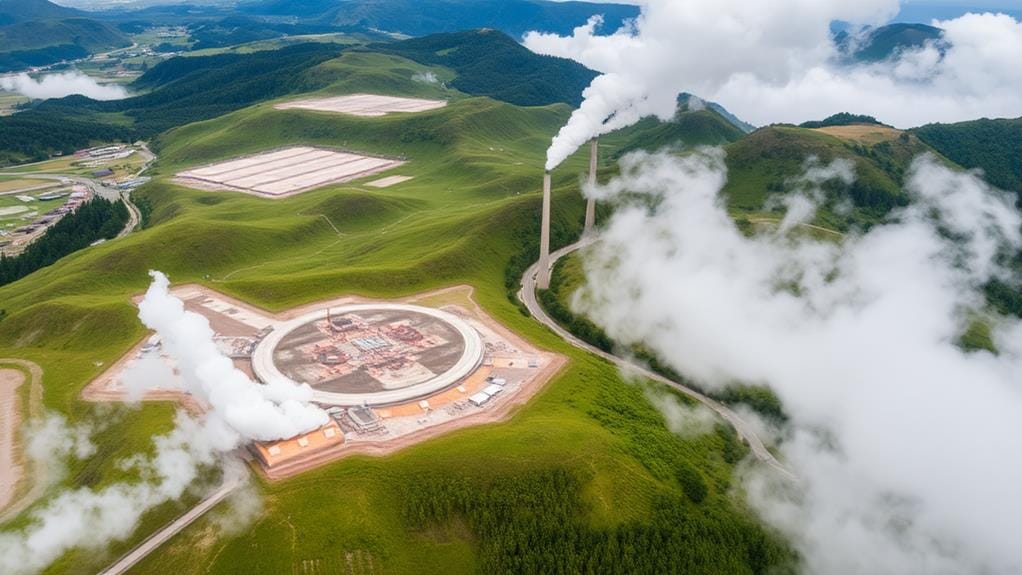
As we shift to discussing air emissions and pollution related to geothermal energy, it is crucial to recognize the various types of emissions produced, as well as the advanced mitigation technologies employed to minimize their impact. By comparing the emissions from geothermal systems to those of traditional fossil fuels, we can better appreciate the significant reductions achieved, particularly with closed-loop systems and binary-cycle plants. Through this analysis, we'll see how the integration of geothermal energy can substantially improve air quality while offering a sustainable alternative for energy generation.
Emission Types Overview
Energy production comes with a variety of emissions, and understanding these is essential as we explore geothermal energy's impact on the environment. Geothermal plants emit approximately 45 grams of carbon dioxide per kWh, considerably lower than coal-fired plants, which highlights their reduced carbon footprint. Open-loop systems can release air emissions, including hydrogen sulfide and carbon dioxide, while closed-loop systems effectively minimize these by re-injecting gases. Enhanced Geothermal Systems (EGS) might induce minor seismic activity, but risks are manageable with proper monitoring. Remarkably, binary-cycle geothermal plants boast nearly zero emissions, contributing to improved air quality. As we increase geothermal energy deployment, we could potentially prevent greenhouse gas emissions equivalent to 26 million cars by 2050, underscoring its environmental benefits.
Mitigation Technologies Employed
Understanding the various emissions associated with geothermal power sets the stage for exploring the innovative mitigation technologies that address air emissions and pollution. Geothermal power plants, particularly binary-cycle systems, have made remarkable strides, releasing fundamentally zero air emissions. By implementing closed-loop systems, we can minimize air emissions, re-injecting gases to prevent harmful substances like hydrogen sulfide and carbon dioxide from entering the atmosphere. Additionally, filtering technologies effectively mitigate mercury emissions, ensuring compliance with environmental standards and reducing health risks. Enhanced Geothermal Systems (EGS) also adhere to a stringent mitigation protocol developed by the U.S. Department of Energy, aimed at managing induced seismicity. Ultimately, increased geothermal deployment is projected to remarkably reduce greenhouse gas emissions, equating to the reduction produced by 26 million cars by 2050.
Comparative Emission Analysis
Geothermal power, with its low-emission profile, stands out when we compare it to traditional fossil fuels. It emits only about 45 grams of carbon dioxide per kWh, far less than coal-fired plants, which can emit between 1,400 to 3,600 grams per kWh. While open-loop geothermal systems do release around 10% of carbon dioxide along with some methane, closed-loop systems minimize atmospheric emissions by re-injecting gases. Significantly, binary-cycle geothermal plants operate with fundamentally zero emissions. By increasing geothermal deployment, we could avoid greenhouse gas emissions equivalent to those produced by 26 million cars by 2050. Overall, geothermal energy produces only one-sixth of the CO2 emissions compared to natural gas plants, highlighting its significant potential as a clean energy resource with a reduced environmental impact.
Land Use and Habitat Impact

When we consider the land use and habitat impact of geothermal power, it's clear that these systems often have a smaller footprint compared to other renewable energy sources like wind and solar farms. Typically requiring about 1-8 acres per megawatt of installed capacity, geothermal projects minimize habitat disruption. For instance, the Geysers geothermal complex in California efficiently occupies around 78 square kilometers while producing 1,517 MW. Enhanced geothermal systems (EGS) further reduce surface disturbance, protecting local ecosystems. Importantly, environmental assessments guide the permitting process, evaluating potential land use impacts. However, we must remain vigilant, as the development of geothermal resources can lead to land subsidence and altered groundwater flow, potentially affecting local habitats if not monitored effectively.
Life-Cycle Emissions Analysis
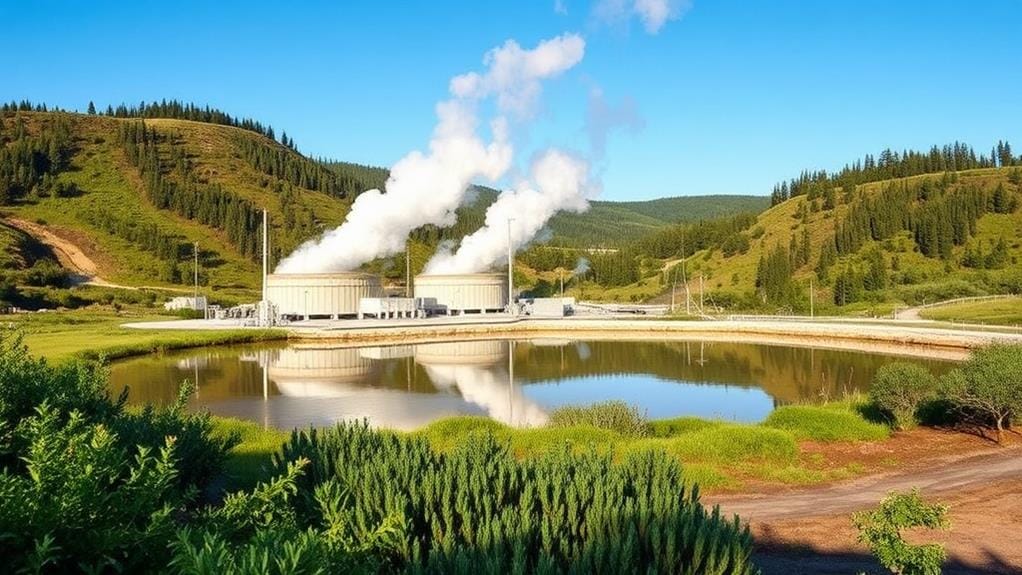
The impact of geothermal energy on land use and habitats sets the stage for examining its life-cycle emissions, which are remarkably low compared to other energy sources. Specifically, geothermal energy, particularly from closed-loop systems, yields life-cycle emissions estimated at approximately 0.1 lbs CO2 equivalent per kWh for open-loop systems and around 0.2 lbs for Enhanced Geothermal Systems (EGS).
| Energy Source | Life-Cycle Emissions (lbs CO2/kWh) | Greenhouse Gas Comparison |
|---|---|---|
| Geothermal (EGS) | 0.2 | One-sixth of natural gas |
| Natural Gas | 1.2 | |
| Coal | 1.4 – 3.6 |
This low carbon footprint underscores geothermal energy's potential as a clean renewable resource, helping to mitigate climate change by potentially avoiding emissions equivalent to 26 million cars by 2050.
Induced Seismicity Concerns
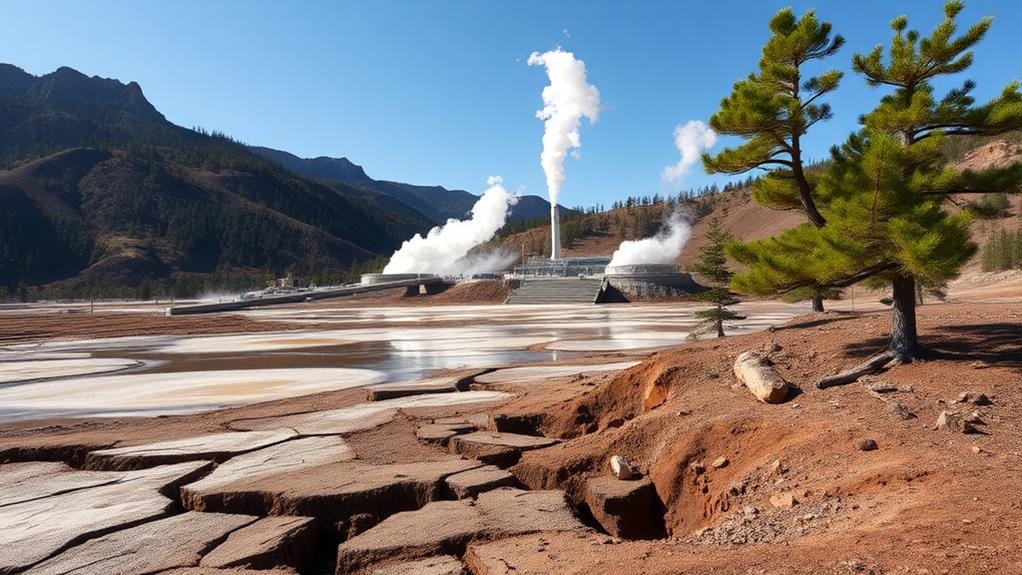
As we explore the concerns surrounding induced seismicity in geothermal energy systems, it's essential to understand the underlying causes, including fluid movement within enhanced geothermal systems (EGS) that may trigger minor earthquakes. We'll also examine the mitigation strategies that have been implemented, such as the U.S. Department of Energy's specific protocols aimed at reducing these risks, along with case studies that illustrate the effectiveness of these measures in real-world applications. By addressing these factors, we can better assess the safety and environmental impacts of expanding geothermal energy deployment.
Causes of Induced Seismicity
Induced seismicity is a significant concern in geothermal energy development, primarily caused by the injection of fluids into wells. When we inject fluid, it alters the pressure and stress in surrounding rock formations, potentially triggering small earthquakes. Several factors influence the extent of these induced seismic events, including the volume of fluid injected, geological characteristics, and proximity to existing fault lines.
| Factor | Impact on Induced Seismicity |
|---|---|
| Volume of Fluid Injected | Higher volumes increase risk |
| Geological Characteristics | Certain formations are more susceptible |
| Proximity to Fault Lines | Closer faults heighten seismic risk |
The U.S. Department of Energy has established a mitigation protocol to manage these risks, emphasizing the importance of monitoring throughout geothermal project operations.
Mitigation Strategies Employed
Addressing the concerns of induced seismicity in geothermal energy development requires a proactive approach. To effectively manage these risks, we implement various mitigation strategies that prioritize public safety. The U.S. Department of Energy has established a protocol specifically for enhanced geothermal systems (EGS), emphasizing the importance of fluid injection management and reservoir pressure control. Seismic monitoring protocols are mandated for all GTO-funded projects, allowing us to assess and manage microseismic activity throughout geothermal operations. Research shows that robust seismic monitoring and rapid response strategies can considerably decrease the likelihood of noticeable seismic events. Additionally, funding for advanced seismic monitoring technologies guarantees we proactively address potential seismic impacts as geothermal systems expand, fostering community confidence in our endeavors.
Case Studies Overview
In examining the case studies of geothermal projects, we see that concerns about induced seismicity often arise, particularly in areas close to populated regions. Induced seismicity can stem from fluid movement in Enhanced Geothermal Systems (EGS), where even microseismic activity is a recognized risk. The U.S. Department of Energy has established a thorough mitigation protocol specifically for EGS, mandating adherence to these guidelines for all GTO-funded projects. Remarkably, the proximity of geothermal operations to communities greatly influences the magnitude and extent of seismic events, raising legitimate public safety concerns. To address these risks, various geothermal projects have implemented robust monitoring protocols that facilitate effective assessment and management of induced seismicity, showcasing how strategic planning can promote safe geothermal energy development.
Economic and Social Impacts
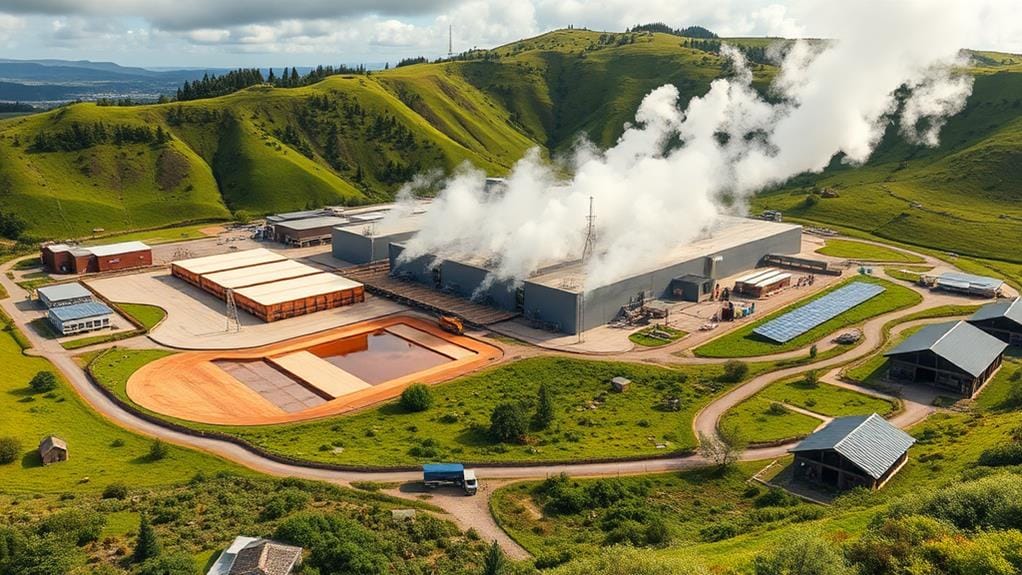
Through the lens of local economies, geothermal energy projects can greatly impact job creation and community development. These initiatives not only generate thousands of direct and indirect jobs associated with plant construction and operation, but they also contribute to the economic impacts within our communities. The generation of tax revenues from geothermal power plants can enhance local infrastructure, fostering community development. Additionally, with levelized energy costs ranging from €0.04 to €0.10 per kWh, we can achieve energy independence, insulating us from fuel price fluctuations. While the initial capital investment is significant, ranging from $4,000 to $6,000 per kWh, the long-term benefits are undeniable.
- Job creation opportunities
- Increased tax revenues
- Stability in energy pricing
- Enhanced local infrastructure
- Reduced fossil fuel reliance
Future Prospects and Innovations
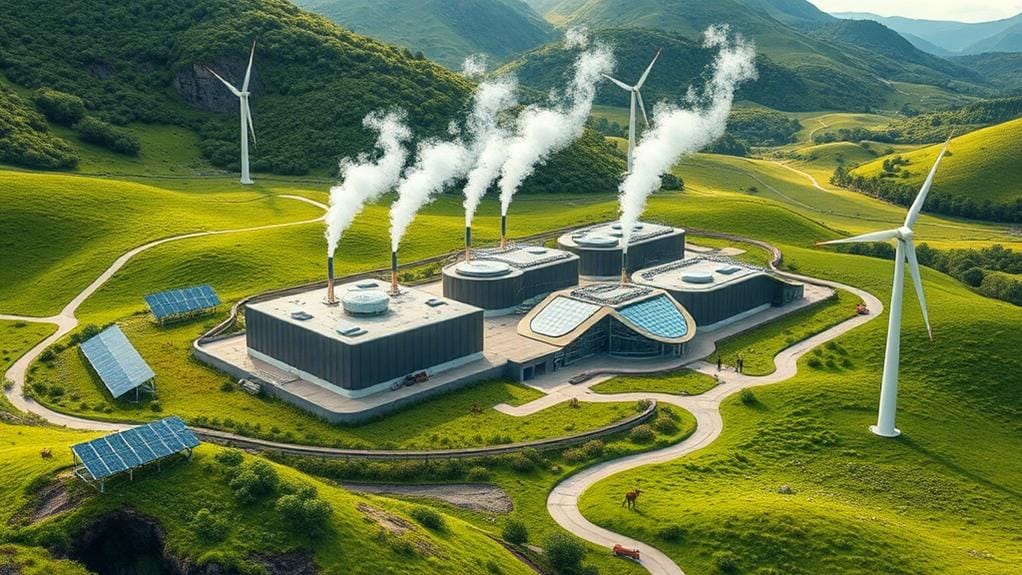
How can we harness the full potential of geothermal energy in the coming years? By focusing on Enhanced Geothermal Systems (EGS) and ongoing technology improvements, we can tap into deeper geothermal resources, expanding our energy infrastructure considerably. Research and development are essential, as innovations in drilling technology are expected to reduce costs while minimizing environmental impacts, making geothermal energy even more competitive with other renewable sources. With projected capacity increases of 20% by 2025, driven by government incentives and a rising demand for sustainability, our commitment to this clean energy source is critical. Additionally, integrating geothermal systems with other renewables can lead to hybrid energy solutions, enhancing reliability and supporting our global climate goals. Together, we can pave the way for a sustainable energy future.
Frequently Asked Questions
What Are the Pros and Cons of Geothermal Energy?
When we explore geothermal energy, we find benefits like energy efficiency and reduced land use, but we should also consider sustainability concerns, water consumption, and potential environmental impacts that could affect our communities long-term.
How Does Geothermal Energy Affect Our Daily Lives?
Imagine our community thriving with geothermal heating, boosting energy efficiency and creating local employment. Together, we can embrace sustainable development and responsible resource management, making a positive impact on our daily lives and future.
Does Geothermal Energy Affect Global Warming?
We believe geothermal energy can markedly reduce our carbon footprint. By utilizing underground reservoirs, it helps in temperature regulation and minimizes geothermal emissions, making it a renewable resource with positive ecological impacts for our planet's future.
Is Geothermal Energy Safe?
As we explore geothermal energy, it's essential to embrace geothermal safety measures. By adhering to regulatory guidelines and conducting thorough environmental impact assessments, we guarantee sustainable resource management and minimize health risks for everyone involved.




